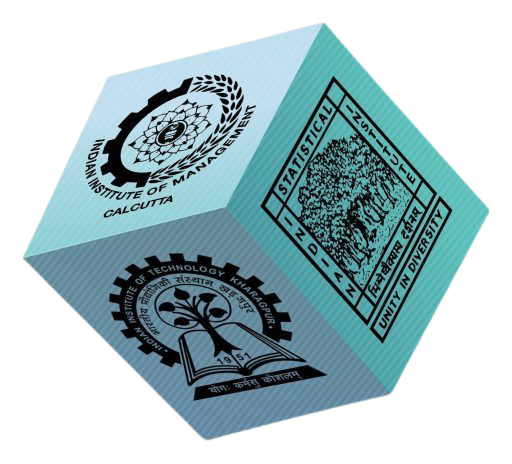What do entropy, linear programming and Riemann surfaces have in common? Puzzled? Now imagine this connection explained by an eccentric speaker in the attire of a French stage magician, with the charm and virtuosity of a storyteller. Cedric Villani, French mathematician, Fields Medal awardee in the year 2010 and famously called by the NewYorker magazine as the ‘Lady Gaga of Mathematics’ delivered a public lecture titled ‘Of Triangles, Gases, Prices and Men’ at ISI on 26th August 2016. The second PGDBA batch, currently in its first semester here at ISI, had the opportunity to be present at this intriguing and informative session.

Cedric Villani
The abstraction and intrigue of Cedric could be assumed from the fact that an introduction to him included a reference to the number of his pets. This abstraction could also be inferred from the title of his talk, which was a play on the title of John Steinbeck’s famous classic ‘Of Mice and Men.’ The first slide of his presentation was taken from Tennyson’s Lady of Shalott. In Cedric’s own interpretation, the Lady of Shalott, accursed to see the world only through a mirror, was actually an allegory to the mathematician forever accursed to look at reality through his equations! Cedric then said that there are many more unsolved mysteries in Mathematics today than there were a hundred years ago. There are ever so many new problems that keep arising. Then there are those age-old ones that lie in famous mathematicians’ lists of unsolved problems. One such famous unproved hypothesis is the Riemann hypothesis. This led Cedric down the path to explaining Riemann’s works and then to the first part of the evening’s presentation – ‘triangles’.
He introduced to the audience Riemann surfaces and how Escher employed curved surfaces in his art. As examples of negative curvatures, he showed images of art installations in museums and models of coral reef. Einstein, with the help of his mathematician colleagues, used Riemann’s ideas to develop his General Theory of Relativity. Cedric went on to add that, the GPS technology so ubiquitous in the world today has its roots in Riemann’s works in topology. In a humorous turn of speech, Cedric noted that Riemann was as oblivious to his work being of practical use in 21st century devices, as modern day GPS users were to Riemann’s surfaces. An ironic symmetry indeed!
At this turn of his presentation, Cedric spoke about how it is equally important for scientists to pursue inspiration and not just utility. He marked out Riemann as someone who was particularly interested in approaching problems in his own unique way. Cedric quoted Poincare who had once said, “Mathematics is the art of giving the same name to different things.” The second part of his talk on ‘gases’ started with a description of his visit to Vienna and a search for Boltzmann’s grave. He said that he stopped to ask a family for a map not expecting them to know Boltzmann, let alone his grave. To his surprise, he was not only directed to the location of the grave but the person also exclaimed Boltzmann’s equation of entropy, “S=klogW”!
In connection with entropy, he then talked about the Gaussian curve, its ubiquitous nature and its uncanny appearance in many natural systems. He called the study of Probability and Statistics as ‘the extraordinary adventure of mastering of chance.’ As a matter of coincidence, he discussed a famous problem in his presentation called ‘Buffon’s needle’, which was also discussed in class earlier on the same day with the PGDBA students by their lecturer. Experiments such as coin tosses, Cedric said, are best done in the most careless ways! Then he explained how gases are modeled as billiard balls in collision and when there are many such sufficiently small billiard balls, their velocities are accurately modeled as the Gaussian distribution. As a note, Cedric remarked on the power of this distribution by quoting Sir Francis Galton who once called it the ‘supreme law of unreason.’
The next part of his presentation was ‘prices’. Cedric introduced Leonid Kantorovic, the father of linear programming. He explained how math is used to model the optimal allocation of resources. He then strung together ideas from the optimized distribution of resources to the distribution of gas molecules with the least loss of energy. The analogy of prices in linear programming is energy in distribution of gas molecules. This is where Cedric began piecing everything together with the last part of his talk called ‘men’. Cedric described how he had happened to meet his collaborators John Lott and Felix Otto. These men put together the ‘triangles’, ‘gases’ and ‘prices’ and helped Cedric complete his research on how fast gases reach the equilibrium stage described in Boltzmann’s equation. Cedric was awarded the Fields medal in connection with this research.
What would have been an intimidating subject matter coming from volumes over volumes of text, was aptly introduced in a two-hour lecture by Cedric Villani, a master at his trade, a storyteller par excellence, a dinosaur catcher in his childhood dreams and a true ambassador of modern mathematics. In a surprising irony of sorts, apart from the many hidden mysteries in the details of his works, the most apparent mystery is the brooches of spiders that he wears on the lapels of his coat!




Be the first to comment